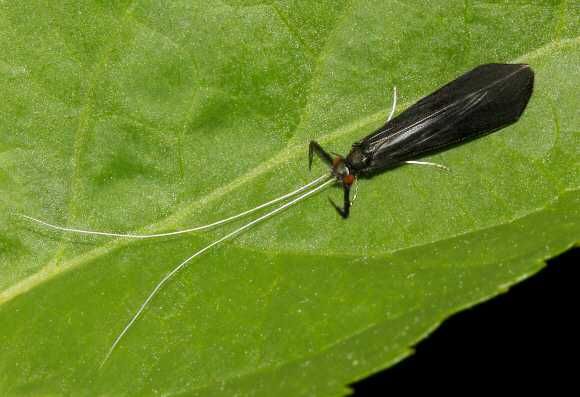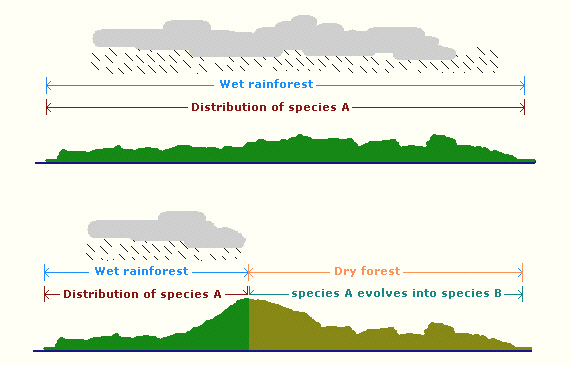The ancestors of butterflies
The strange creature below is a longhorn caddis fly Mystacides azurea from England. The ‘pincers’ are highly modified palpi which are used to grip and manipulate the female prior to mating. Caddis flies are the ancient ancestors of butterflies and moths. Their larvae are aquatic and live in portable cases constructed from sand grains or fragments of stems bonded to a silk tube surrounding their body. Modern day bagworm moths ( Psychidae ) still have larvae which live inside cases.

The fossil record
The first insects appeared on Earth about 300 million years ago. The earliest Lepidoptera evolved from the Trichoptera ( caddis flies ) about 140-200 mya, coinciding with the appearance of the first flowering plants. The fossilised butterfly Prodryas persephone ( Nymphalidae ) was found in the Florissant beds, Colorado, USA and dates from the Oligocene period, 30mya.
Where & when did the first butterflies appear ?
Long ago the land masses of the Earth were divided into 4 continents – Laurentia, Baltica, Siberia and Gondwanaland. They gradually converged, and about 350 mya became linked, forming the super-continent Pangaea. It seems probable that the earliest butterflies originated on Pangaea, which then began to break up about 130 mya, ultimately forming the present day continents. This may partly explain why all the butterfly families are represented on more than one continent.
A few subfamilies, and many tribes, are limited in their global distribution – the Ithomiini e.g. are found only in the neotropics, and the Tellervini only in the Australian ( Papuan ) region. It seems likely that the latter evolved from their alleged parent subfamily Danainae, AFTER the break-up of Pangaea. However, it is important to realise that the break-up was very gradual, and it is quite possible that all subfamilies and genera may have come into existence at a time when the new continents were still partially linked.
Evolutionary Theory
The philosopher Aristotle ( 384-322 BC ) believed in spontaneous generation – the notion that all living things arose from non-living sources. This probably reflected unexplained phenomena such as swarms of flies apparently being generated spontaneously from dead carcasses. This in turn may have led to religious concepts of reincarnation, resurrection and the ‘soul’. St Thomas Aquinas even concluded that the spontaneous generation of insects was the work of the devil!
The notion of evolution was first mooted by the French biologist Jean-Baptiste Lamarck in 1800. He believed that animal anatomy and behaviour were not fixed, but adapted to circumstances. Lamarck considered that these adaptations could be transmitted to new generations. He believed evolution was driven by 2 forces – one which drove animals from simple to complex forms, and another that adapted animals to local environments and differentiated them from each other.
Darwin’s Theory of Evolution
Charles Darwin went further when in 1859 he published ‘The Origin of Species’ which theorised that all animals evolved by a process of natural selection from more basic life forms. After considerable initial opposition the scientific world accepted and expanded these theories, concluding that life began billions of years ago when viruses, bacteria or similar ‘primitive’ entities somehow arose in the ‘primordial soup’ of early oceans. Put simply, the theory states that adaptations or traits occur naturally in a percentage of a population due to mutation. Evolution occurs as the more successful adaptations become dominant, and former traits are bred out by the natural selection process.
Speciation
Environmental conditions change over a period of time, during which the less adaptable life forms become extinct. Others acquire, via the birth of mutant offspring, new properties that make them more capable of surviving. These traits can be transmitted genetically to future generations, as demonstrated by Mendel’s experiments with hybridisation in the late 19th century.
Most theorists believe that new species probably evolve when the habitat of the ancestral species undergoes major changes. Only those mutations that are able to survive these changes can pass on their genes to future generations. The ancestral form often becomes extinct, and the new form evolves over a period of time, eventually becoming so different from its ancestor that it is regarded as a new species.
Evolution does not however necessarily require extinction of the ancestral species. Natural barriers can emerge such as wide rivers, deserts or mountain ranges, which isolate populations of a given species from each other. In isolation the natural variation which exists in any population will ensue that new traits arise in both populations. One type of biological or behavioural trait may work best in population A, while a very different adaptation may work better in the environment occupied by population B. Thus, provided that their ranges do not overlap, two ‘subspecies’ will evolve.
The figure below illustrates how an emerging mountain range can split a butterfly population. The environment of one population remains largely unchanged, but the other population is subjected to a much drier climate in the rain-shadow of the mountain. In the latter population, only the variants( mutations) that are best suited to the new environment will survive and pass on their genes to the next generation. A process of natural selection ‘survival of the fittest’ will slowly bring about the evolution of a new species.

Speciation Frequency
There are several factors affecting the rate at which speciation occurs. It is likely to happen more frequently at habitat boundaries, where an existing species has to adapt it’s biology and behaviour in order to survive on different foodplants or in different habitats.
It will also be more frequent in tropical habitats than in temperate regions, because there will be more generations during any given time period. In subarctic regions many species take 2 years to complete their lifecycle. The moth Gynaephora groenlandica spends up to 14 years as a larva!
Most butterflies in temperate North America and Europe produce one or two generations each year. In the tropics however there can be 10 or more generations in the same period. The entire lifecycle of one common tropical butterfly Hypolimnas misippus takes only 23 days to complete.
The more generations there are in a year, the more chances there are for random mutations to occur, and the more opportunities there are for speciation. It has been mathematically calculated that complete substitution of a gene under a natural selection rate of only 1% takes less than 4000 generations. In the case of a species like Heliconius erato, which produces 10 generations a year it it quite feasible then for speciation to occur at intervals of just 400 years.
Is the ‘subspecies’ a valid taxon?
Subspecies are really nothing more than convenience names given to geographically isolated races which have adapted to various environments and evolved new anatomical / behavioural traits that improve their survival rate. These races are capable of interbreeding and producing fertile offspring if brought together in a laboratory. They do not normally interbreed in the wild due to geographical separation, but there are many cases particularly in Amazonia where subspecies have been able to expand their range to the point where they overlap and interbreed with another subspecies.
Examples of subspecies include Papilio machaon brittanicus which is widely distributed throughout the Holarctic region but in Britain is restricted to the Norfolk Broads; and Hipparchia semele thyone and Plebejus argus caernensis, both of which occur across much of the Holarctic including Britain, although these particular subspecies are restricted to a tiny area in north Wales.
Most biologists regard the species as the terminal taxon, with the subspecies being a stepping stone, a transitional taxon which is part of the process of speciation. They consider that subspecies in time will theoretically evolve into new species, replacing, or in some cases existing alongside the ancestor species.
